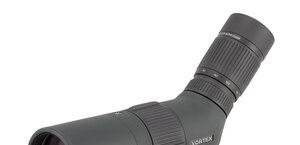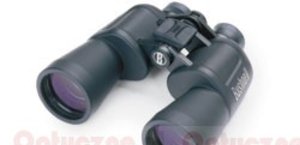Bynolyt Hawk 10x42 BCF
The offer is quite wide. The cheapest instruments are made in China, the more expensive ones - in Japan so the company’s strategy is aimed at tapping all price segments and we can find binoculars with the objective lenses’ diameters from 21 to 63 mm on its offer.
One of more interesting porro prism binoculars’ ranges is the Hawk series, including 8x42 and 10x42 models. Those stylish and solid instruments come from the medium price segment. Of course they are waterproof and nitrogen-filled and all air-to-glass surfaces are covered by antireflection multilayer coatings. The binoculars boast comfortable eye relief (18-19 mm) which allows observations even for people wearing glasses.
| Magnification | Lens diameter | Angular field of view | Prisms | Eye relief | Weight | Price |
|---|---|---|---|---|---|---|
| 10 | 42 | 88/1000(5o) | BaK-4/Porro | 18 mm | 715 g | 1470 PLN |
Summary
Pros:
- very solid housing with a hidden ocular bridge,
- good transmission,
- negligible astigmatism,
- low coma,
- slight chromatic aberration,
- well-controlled distortion,
- sharp image in almost whole field of view,
- excellent whiteness rendition,
- good quality prisms,
- practically unnoticeable light fall-off near the field border,
- long guarantee.
Cons:
- narrow field of view,
- inner flares-prone,
- truncated pupils, not very welcome in this equipment class,
- focusing screw could have had less sharp projections edges
- the objective lenses are closer to 41 mm than to 42 mm.
The mere comparison of the number and significance of pros and cons, and one glance at the final score allow us to speak about this device mostly in superlatives. The product is really well-made although its excellent optical properties were achieved by narrowing the field of view. In the 10x42 class binoculars the 5.1 degrees field of view is a bit too small, especially that the competitors can have even the value of 6.5 degrees here. However, if the field of view is of no particular importance to you, the Bynolyt Hawk 10x42 will be undoubtedly an excellent choice.
At the end there’s just one question left to be answered: does the Bynolyt Hawk 10x42 and the Opticron HR WP 10x42 are exactly the same instruments? They almost for sure come from the same factory. They even look practically the same. One look at their parameters, though, reveals first differences – minimally different weight and eye relief value. It suggest a different eyepieces’ construction although their field of view remains the same. That hypothesis seems to be confirmed by the distortion and field edge blur measurements. Opticron focused on the very sharp field of view, practically up to the edge, but had to pay for it – the distortion is distinct. Bynolyt decided to compromise a bit in both cases. The next difference, very easy to spot, is a different hue of the objectives and eyepieces’ coatings although in both instruments they do an equally good job. The exit pupils also look different – they are truncated in various ways which might suggest a different fixing the prisms. The focusing works a bit differently too. In the Bynolyt it has the range from 2.90 meters to infinity. Opticron, taking care of ornithologists, moved the working range of the bridge so the binoculars have a minimal focus already from 2.7 meters; it might cause some potential problems with focusing for people with sight defects, though. The binoculars are not identical then, they differ in their constructions, the price and they have a different score in our test. We hope we made the choice a bit easier for you.

















